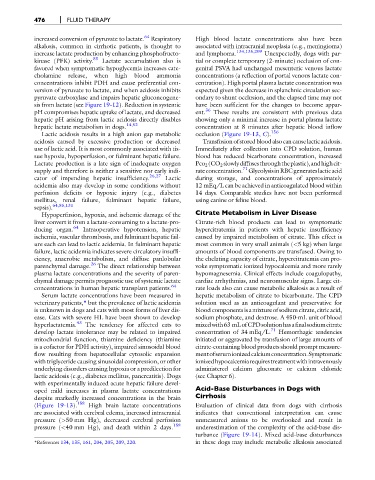Page 488 - Fluid, Electrolyte, and Acid-Base Disorders in Small Animal Practice
P. 488
476 FLUID THERAPY
increased conversion of pyruvate to lactate. 64 Respiratory High blood lactate concentrations also have been
alkalosis, common in cirrhotic patients, is thought to associated with intracranial neoplasia (e.g., meningioma)
increase lactate production by enhancing phosphofructo- and lymphoma. 134,135,209 Unexpectedly, dogs with par-
kinase (PFK) activity. 85 Lactate accumulation also is tial or complete temporary (2-minute) occlusion of con-
favored when symptomatic hypoglycemia increases cate- genital PSVA had unchanged mesenteric venous lactate
cholamine release, when high blood ammonia concentrations (a reflection of portal venous lactate con-
concentrations inhibit PDH and cause preferential con- centration). High portal plasma lactate concentration was
version of pyruvate to lactate, and when acidosis inhibits expected given the decrease in splanchnic circulation sec-
pyruvate carboxylase and impairs hepatic gluconeogene- ondary to shunt occlusion, and the elapsed time may not
sis from lactate (see Figure 19-12). Reduction in systemic have been sufficient for the changes to become appar-
pH compromises hepatic uptake of lactate, and decreased ent. 36 These results are consistent with previous data
hepatic pH arising from lactic acidosis directly disables showing only a minimal increase in portal plasma lactate
hepatic lactate metabolism in dogs. 14,52 concentration at 8 minutes after hepatic blood inflow
Lactic acidosis results in a high anion gap metabolic occlusion (Figure 19-13, C). 156
acidosis caused by excessive production or decreased Transfusionofstoredbloodalsocancauselacticacidosis.
use of lactic acid. It is most commonly associated with tis- Immediately after collection into CPD solution, human
sue hypoxia, hypoperfusion, or fulminant hepatic failure. blood has reduced bicarbonate concentration, increased
Lactate production is a late sign of inadequate oxygen Pco 2 (CO 2 slowlydiffusesthroughtheplastic),andhighcit-
71
supply and therefore is neither a sensitive nor early indi- rateconcentration. GlycolysisinRBCgenerateslacticacid
cator of impending hepatic insufficiency. 26,27 Lactic during storage, and concentrations of approximately
acidemia also may develop in some conditions without 12 mEq/L can be achieved in anticoagulated blood within
perfusion deficits or hypoxic injury (e.g., diabetes 14 days. Comparable studies have not been performed
mellitus, renal failure, fulminant hepatic failure, using canine or feline blood.
sepsis). 64,85,131
Hypoperfusion, hypoxia, and ischemic damage of the Citrate Metabolism in Liver Disease
liver convert it from a lactate-consuming to a lactate-pro- Citrate-rich blood products can lead to symptomatic
ducing organ. 64 Intraoperative hypotension, hepatic hypercitratemia in patients with hepatic insufficiency
ischemia, vascular thrombosis, and fulminant hepatic fail- caused by impaired metabolism of citrate. This effect is
ure each can lead to lactic acidemia. In fulminant hepatic most common in very small animals (<5 kg) when large
failure, lactic acidemia indicates severe circulatory insuffi- amounts of blood components are transfused. Owing to
ciency, anaerobic metabolism, and diffuse panlobular the chelating capacity of citrate, hypercitratemia can pro-
parenchymal damage. 26 The direct relationship between voke symptomatic ionized hypocalcemia and more rarely
plasma lactate concentrations and the severity of paren- hypomagnesemia. Clinical effects include coagulopathy,
chymal damage permits prognostic use of systemic lactate cardiac arrhythmias, and neuromuscular signs. Large cit-
concentrations in human hepatic transplant patients. 64 rate loads also can cause metabolic alkalosis as a result of
Serum lactate concentrations have been measured in hepatic metabolism of citrate to bicarbonate. The CPD
veterinary patients,* but the prevalence of lactic acidemia solution used as an anticoagulant and preservative for
is unknown in dogs and cats with most forms of liver dis- blood componentsisamixtureofsodiumcitrate,citricacid,
ease. Cats with severe HL have been shown to develop sodium phosphate, and dextrose. A 450-mL unit of blood
hyperlactatemia. 43 The tendency for affected cats to mixedwith63 mLofCPDsolutionhasafinalsodiumcitrate
develop lactate intolerance may be related to impaired concentration of 34 mEq/L. 71 Hemorrhagic tendencies
mitochondrial function, thiamine deficiency (thiamine initiated or aggravated by transfusion of large amounts of
is a cofactor for PDH activity), impaired sinusoidal blood citrate-containing blood products should prompt measure-
flow resulting from hepatocellular cytosolic expansion mentofserumionizedcalciumconcentration.Symptomatic
with triglyceride causing sinusoidal compression, or other ionizedhypocalcemiarequirestreatmentwithintravenously
underlying disorders causing hypoxia or a predilection for administered calcium gluconate or calcium chloride
lactic acidosis (e.g., diabetes mellitus, pancreatitis). Dogs (see Chapter 6).
with experimentally induced acute hepatic failure devel-
oped mild increases in plasma lactate concentrations Acid-Base Disturbances in Dogs with
despite markedly increased concentrations in the brain Cirrhosis
(Figure 19-13). 158 High brain lactate concentrations Evaluation of clinical data from dogs with cirrhosis
are associated with cerebral edema, increased intracranial indicates that conventional interpretation can cause
pressure (>50 mm Hg), decreased cerebral perfusion unmeasured anions to be overlooked and result in
pressure (<40 mm Hg), and death within 2 days. 158 underestimation of the complexity of the acid-base dis-
turbance (Figure 19-14). Mixed acid-base disturbances
*References 134, 135, 161, 204, 205, 209, 220. in these dogs may include metabolic alkalosis associated

